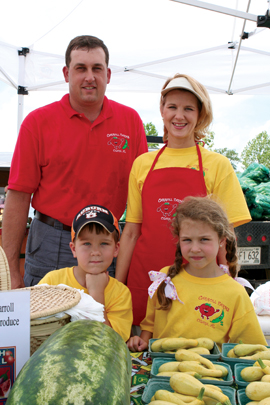OYFF Horticulture Winner: Carrolls’ Garden Market Just Keeps On Growing

Monica Carroll knew it wouldn’t be easy to convince her husband, Chris, to add a vegetable garden and produce stand to their poultry and cattle farm’s repertoire.For one thing, they lived about five miles from Ozark, and the odds of attracting customers from town were pretty slim. For another, Chris, by his own admission, “despised” vegetable gardens.”I grew up on a farm and my daddy was always the two- or three-acre garden-type, and I literally despised it,” said Chris. “I told Mom that if I ever got away from it, I would never have another one.”But when the Carrolls’ poultry integrator left their poultry houses without chickens for almost 30 days three times in one year, both knew something had to be done.”They did that for three batches, which is almost a half a year,” said Monica. “It didn’t take me long to figure out that, ‘Hey, we’ve just had a batch of chickens cut out of our income!’ And here I was — I had quit a good job with the USDA, and I was a little nervous. I’ll be honest — I was scared.”Today, the Carrolls — Chris, Monica, 6-year-old Brittany and 5-year-old Blake — are recognized as the Alabama Farmers Federation’s Outstanding Young Farm Family in the Horticulture Division.But Chris is quick to give credit where it’s due: “The vegetables were Monica’s brainchild,” he said. “When she first told me that she wanted to grow peas, I told her, ‘If you sell five hampers of peas all year long, I’ll be surprised.’ I just didn’t think anybody would drive all the way out to the farm because we’re about five miles out of town, and we’re a rural town to start with.”Nevertheless, he gave Monica a shot at in 2002 after making one thing clear: “Marketing is YOUR part; growing is MY part.”
That year, the Carrolls planted six acres — watermelons, squash, cucumbers, tomatoes, peas and butterbeans. Monica then set out to spread the word about their new venture. “Those first two years, we were just begging for customers, trying to get our name out, advertising,” she said. “We set up a little table on the carport so people could see it,” said Monica. “I had some scales set up because we sold it by the pound. My first customer was Kathleen Waters, a Century 21 agent. I’ll never forget her.”That first year, half of the produce was sold wholesale to SuperSave, Piggly Wiggly, outlets and others; the other half was sold retail through their carport produce stand and U-pick fields.But much has changed since that time. Today, their Dale County fruit and vegetable farm is blanketed in 85 acres of butterbeans, peas, watermelons, sweet corn, squash, cucumbers and strawberries. Each year, the crops are rotated to help reduce the need for insecticides and herbicides. “We’re not organic, but I’m not big on using a lot of sprays either,” Monica said. “That’s sort of been our niche.””We try to grow a good variety because I’ve been told that the more variety you have, the longer people will stay and the longer they stay, the more they will buy,” she added. “So hopefully, when people come in here, they can find just about anything they want.”Obviously, they are finding what they want. About 95 percent of the Carrolls’ produce is now sold retail from their U-pick fields, farmers markets and produce stand, which will be expanded from 800 square feet to 6,000 square feet in time for next season. “I’ve gone from 200 bushels of peas and butterbeans my first year to almost 4,000 bushels this year. Our first year, we picked 182 bushels of sweet corn off of our first acre and wholesaled half of that” Monica marvels. “When that second acre came in, we got about 134 bushels and sold it all retail. It’s a blessing. It amazes me, humbles me, that people think that much of our stuff.”Likewise, their labor needs have grown. Monica once relied on teenage girls to baby-sit the kids, but soon decided that’s not what she wanted. “That’s not why I quit my job and came home,” she said. “I came home to be with them. So this year, we hired a couple of ladies (Sonya Beasley, fulltime, and Nancy Lewis, part-time) to help with the produce, and that way, the children can be with me.” Of course, the fruit and vegetable business is still only part of the Carrolls’ operation. There are still four broiler houses that must be worked, and there’s the pumpkin patch that draws in more visitors each fall. Chris sold his beef brood cowherd due to the drought, but will continue his pre-conditioning facility where he and two other partners will background up to 500 yearlings this winter. January is reserved for the family’s hunting lodge, where up to four outfitters take groups out on deer and turkey hunts.”February is our time to plan,” said Monica. “Chris is real big on planning. He says, ‘Plan your work and work your plan.’ That’s his motto. But when February comes around and I start getting my seed catalogs, I get excited. Even Chris gets to thinking about where he’s going to plant and how we’ll do our rotations.””The vegetables have been good for our farm,” Chris says now. “It really has. It brings people to our farm, and it’s been a good sideline income. Monica does an extremely good job with the market. I’m not a people person; she’s definitely a people person. That’s what it takes — you’ve got to have good produce, and you’ve got to have somebody who can relate to people. She’s really good at it.”
